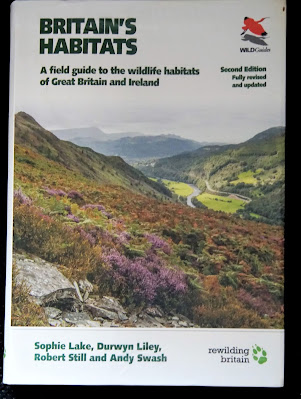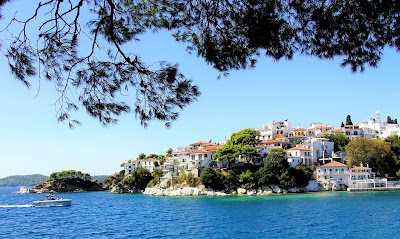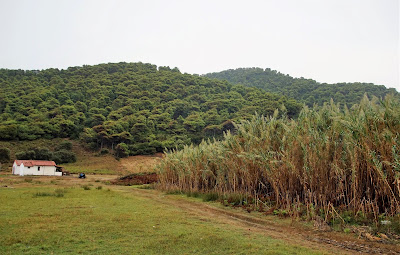When I arrived back from Greece a parcel awaited me – a book. Unfortunately the parcel got a little wet from White Van Man’s hiding place under a garden bench where it lay for five or six days. Therefore apologies if my images of pages appear water damaged – they are.
My friends at Princeton University Press sent this new book for review, one they thought would be of interest to followers of Another Bird Blog. The book is the latest of the WildGuides series and carries the title BRITAIN’S HABITATS - A field guide to the wildlife habitats of Great Britain and Ireland . This is a fully revised and updated Second Edition following on from the First Edition published six years ago in November 2014.
BRITAIN’S
HABITATS - Princeton University Press
Two of the authors, Sophie Lake and Durwyn Liley are professional ecologists of some twenty years’ experience and with a passion for natural history, ecology and the environment. The other two writers, Robert Still and Andy Swash are also ecologists and co-authors of other WildGuides titles.
This 2020 volume contains over 400 pages jam-packed with authoritative, detailed and specialised knowledge about the natural history of wildlife habitats in Britain and Ireland. There are more than 900 colour photographs from around Britain and Ireland with details and images of key species and features that apply to all habitat types. One of the new added extras to this edition is the inclusion of “gardens”, a deserved nod to the phenomenon of citizen science and the importance of data collected in the ever growing suburbia of Britain and Ireland of 2020.
BRITAIN’S HABITATS - Princeton University Press
The introductory pages 8 to 39 are essential reading, explaining as they do the classifications that follow from page 40 which describe how each environment has formed. Each habitat is allocated two to four pages in which its characteristics are summarised along with its origins and development, the conservation needs and the flora and fauna that live there. The sections are illustrated by several excellent photographs in each that show typical examples of the habitat together with a representative selection of its plants, animals, birds and insects.
This introductory chapter includes a historical timeline and maps showing the geology and climate of the British Isles. Pages 28-29 “Humans” displays a timeline of key events where man played major parts in influencing how Britain and Ireland changed. These two pages travel from the Glacial Period through to man’s arrival in Britain and Ireland, and then up to the present day when 15% of assessed species are in danger of extinction.
Following the introduction is the bulk of the book comprising individual sections for each of nine principal habitats - woodland, scrub, heath-land, grassland, mountain, rocky, wetlands, freshwater, coastal, and other. “Other” consists of brownfield, orchard, garden and arable.
Arable is at the present time thought to be 25% of Britain and 15% of Ireland cultivated land, a figure that will surely decrease as both nations continue to devalue the culture and history of arable farming in favour of grass for animal feed and the consumption of meat. As the authors point out, a suite of ephemeral plants was once widespread across arable land but where the use of agrochemicals and intensive farming techniques has led to the loss and even extinction of some plants valuable to insects, birds and small mammals.
BRITAIN’S HABITATS - Princeton University Press
BRITAIN’S HABITATS - Princeton University Press
Each of the sections is further sub-divided into variants e.g, for woodland the sub-sections comprise Lowland mixed, Lowland dry, Beech, Yew, Wet, Wood Pasture, Upland Oak, Upland Mixed, Caledonian, Atlantic Hazel, Upland Birch and Coniferous.
This format works beautifully by describing the types of vegetation that characterises each variation and the flora & fauna within. The structured and consistent layout of the book makes for easy location of individual accounts and the comparison of the habitats described. The text is easy to read and embrace while remaining not overly scientific. For readers like me with a major interest in just one branch of natural history (birds) the book opens up a treasure trove of previously unknown landscape, habitat and flora & fauna - Transition Mire, Alpine Pennygrass, the Whelk-shell Jumping Spider or the Scaley Cricket!
These habitats and the creatures within constantly evolve as their numbers fluctuate, mostly downwards in recent times due to the malign influence of man. Yet, all need conserving if their particular individuality so that their common or often unique species can survive.
This becomes the great strength of the book – an all-encompassing realisation that we are all in this together. Man will only survive if to the best of his ability he preserves not just individual species but the unique landscape and habitat of his environment and all of the creatures within.
BRITAIN’S HABITATS - Princeton University Press
I thoroughly enjoyed my time with this book and for sure I will consult it frequently in future days and weeks. My only reservation is that the book presents as a field guide when in fact it will surely become a source of reference to amateurs and professionals alike in the field of ecological study and assessment. As such it is unlikely to be carried into the field and therefore deserves a larger format than 6” x 9” and where it can be consulted at more leisure, probably in a library, university, college or on the bookshelf of a professional ecologist.
I think that anyone with an interest in the outdoors will thoroughly enjoy this book and perhaps as a result see the environment as a whole and how it fits together rather than the narrow focus of many naturalists. I recommend it to all readers of Another Bird Blog.
BRITAIN’S HABITATS - A field guide to the wildlife habitats of Great Britain and Ireland is on sale now. Princeton University Press
$32.50 / £25.00
ISBN: 9780691203591
Published: 24/11/2020










































































.jpg)












